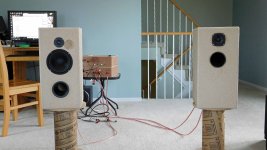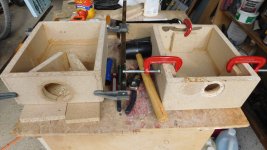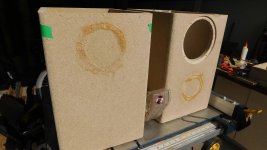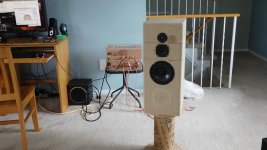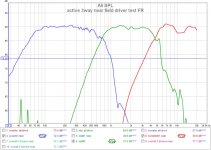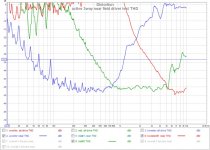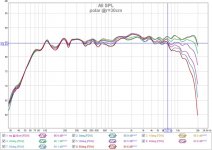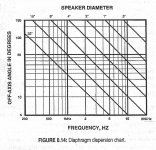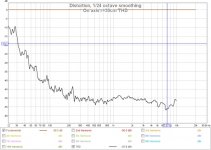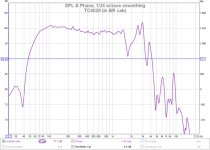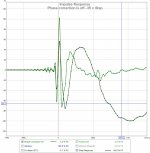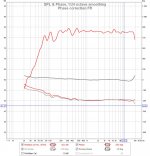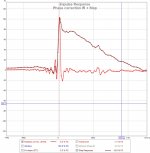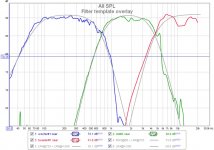I've been wanting to try this for a while. I've been building the knowledge (generous help from DIYaudio members) and acquiring the pieces for it over the last year.
I call this a "work in progress" because I'll be changing drivers and configurations until I'm happy with it. A modular design should accomodate this. So no pretty packaging for now.
--------------------------------------------------------
- V1 : woofer=tc6028, midrange=pc83, tweeter=td20f :
Modular active 3 way - work in progress
- V2 : woofer=tc6028, midrange=rs52an, tweeter=td20f
Modular active 3 way - work in progress
- V3 : 2x woofer=tc6028, midrange=rs52an, tweeter=td20f
Modular active 3 way - work in progress
- V4 : 2x woofer=tc6028, midrange=rs52an, tweeter=td20f
Modular active 3 way - work in progress
- V5 : 2x woofer=W20RC380, midrange=rs52an,tweeter=dc28f
Modular active 3 way - work in progress
- V6 : 2x woofer=W20RC380, midrange=rs52an,tweeter=dc28f
Modular active 3 way - work in progress
- V7 : 4x woofer=tc6028, midrange=rs52an,tweeter=dc28f
Modular active 3 way - work in progress
- V8 : 4x woofer=tc6028, midrange=prv290 + sh402, tweeter=cd130+h07e
Modular active 3 way - work in progress
- V9 : 4x woofer=tc6028, midrange=prv290 + phrn1014, tweeter=cd130+ebay slotted
Modular active 3 way - work in progress
- V10: 4x woofer=DSA175, midrange=RS52an, tweeter=DC28f
https://www.diyaudio.com/community/threads/modular-active-3-way-work-in-progress.326926/post-6310628
- V11: 4x woofer=DSA175, midrange=ZXPC-11x17 + D2200Ph, tweeter=Dayton H07E + CD130
https://www.diyaudio.com/community/threads/modular-active-3-way-work-in-progress.326926/post-6914493
---------------------------------------------------------
Misc other tools and equipment
- turn table for polar measurements
https://www.diyaudio.com/community/threads/modular-active-3-way-work-in-progress.326926/post-6238989
- circle cutting jig
https://www.diyaudio.com/community/threads/modular-active-3-way-work-in-progress.326926/post-6246764
- fan speed control for amplifiers
https://www.diyaudio.com/community/threads/modular-active-3-way-work-in-progress.326926/post-6337253
- plain wave tubes (built 1inch and 2inch)
https://www.diyaudio.com/community/threads/modular-active-3-way-work-in-progress.326926/post-6544772
- acoustic impedance measurement tube
https://www.diyaudio.com/community/threads/modular-active-3-way-work-in-progress.326926/post-6553137
- UMIK1 repair
https://www.diyaudio.com/community/threads/modular-active-3-way-work-in-progress.326926/post-6899378
- optical intf DAC
https://www.diyaudio.com/community/threads/modular-active-3-way-work-in-progress.326926/post-6899483
---------------------------------------------------------
I call this a "work in progress" because I'll be changing drivers and configurations until I'm happy with it. A modular design should accomodate this. So no pretty packaging for now.
--------------------------------------------------------
- V1 : woofer=tc6028, midrange=pc83, tweeter=td20f :
Modular active 3 way - work in progress
- V2 : woofer=tc6028, midrange=rs52an, tweeter=td20f
Modular active 3 way - work in progress
- V3 : 2x woofer=tc6028, midrange=rs52an, tweeter=td20f
Modular active 3 way - work in progress
- V4 : 2x woofer=tc6028, midrange=rs52an, tweeter=td20f
Modular active 3 way - work in progress
- V5 : 2x woofer=W20RC380, midrange=rs52an,tweeter=dc28f
Modular active 3 way - work in progress
- V6 : 2x woofer=W20RC380, midrange=rs52an,tweeter=dc28f
Modular active 3 way - work in progress
- V7 : 4x woofer=tc6028, midrange=rs52an,tweeter=dc28f
Modular active 3 way - work in progress
- V8 : 4x woofer=tc6028, midrange=prv290 + sh402, tweeter=cd130+h07e
Modular active 3 way - work in progress
- V9 : 4x woofer=tc6028, midrange=prv290 + phrn1014, tweeter=cd130+ebay slotted
Modular active 3 way - work in progress
- V10: 4x woofer=DSA175, midrange=RS52an, tweeter=DC28f
https://www.diyaudio.com/community/threads/modular-active-3-way-work-in-progress.326926/post-6310628
- V11: 4x woofer=DSA175, midrange=ZXPC-11x17 + D2200Ph, tweeter=Dayton H07E + CD130
https://www.diyaudio.com/community/threads/modular-active-3-way-work-in-progress.326926/post-6914493
---------------------------------------------------------
Misc other tools and equipment
- turn table for polar measurements
https://www.diyaudio.com/community/threads/modular-active-3-way-work-in-progress.326926/post-6238989
- circle cutting jig
https://www.diyaudio.com/community/threads/modular-active-3-way-work-in-progress.326926/post-6246764
- fan speed control for amplifiers
https://www.diyaudio.com/community/threads/modular-active-3-way-work-in-progress.326926/post-6337253
- plain wave tubes (built 1inch and 2inch)
https://www.diyaudio.com/community/threads/modular-active-3-way-work-in-progress.326926/post-6544772
- acoustic impedance measurement tube
https://www.diyaudio.com/community/threads/modular-active-3-way-work-in-progress.326926/post-6553137
- UMIK1 repair
https://www.diyaudio.com/community/threads/modular-active-3-way-work-in-progress.326926/post-6899378
- optical intf DAC
https://www.diyaudio.com/community/threads/modular-active-3-way-work-in-progress.326926/post-6899483
---------------------------------------------------------
- Donor boxes and the initial drivers : silk purse from sows ear contest?
- Active analog 3 way XO : Budget active 3 way crossover - buy, eval, mod
- Active analog subwoofer adj bandpass : Budget active subwoofer lowpass, buy, eval, mod
- Class D amps : OmniDirectional - work in progress
- RPI3B + Piano DAC : Raspberry Pi with Piano2.1 DAC DSP and Volumio2
Last edited:
slice & dice
The enclosures and drivers are recycled. They're low cost and allow me to try things and set the starting bar.
The donors are the first pic and come from a budget project. I can make a box pretty fast using a pnuematic nailer and glue, I just don't like repeating the same built just to change one small part. The donors were sliced, holes filled and ends capped to make sections that stack neatly (last pic). I will be adding 3 alignment pins to prevent shift & topple.
Initial donor driver set [woofer=tc6028, midrange=pc83, tweeter=td20f]. They cost in total $30 US for the set.
The enclosures and drivers are recycled. They're low cost and allow me to try things and set the starting bar.
The donors are the first pic and come from a budget project. I can make a box pretty fast using a pnuematic nailer and glue, I just don't like repeating the same built just to change one small part. The donors were sliced, holes filled and ends capped to make sections that stack neatly (last pic). I will be adding 3 alignment pins to prevent shift & topple.
Initial donor driver set [woofer=tc6028, midrange=pc83, tweeter=td20f]. They cost in total $30 US for the set.
Attachments
Initial measurements
A quick set of near field measurements (1/24 oct, no smoothing, no EQ) to see if its working properly. The drivers have different sensitivity that were compensated using the amps to level it out.
XO points were chosen to give each driver approx 2.5 octaves operating range.
sub(s) : 20-100Hz (2.3 oct)
woofer : 100-725Hz (2.86 oct)
midrange : 725-4.5Khz (2.65 oct)
tweeter : 4.5Khz-20Khz (2.1 oct)
Interesting to note. Each driver can manage -50dB THD in its operating range when connected directly to an amp. The driver's are also pretty flat considering their cost and restricted operating range. The tweeter has a a 2db dip from 9Khz-13Khz that could be EQ'd out.
A quick set of near field measurements (1/24 oct, no smoothing, no EQ) to see if its working properly. The drivers have different sensitivity that were compensated using the amps to level it out.
XO points were chosen to give each driver approx 2.5 octaves operating range.
sub(s) : 20-100Hz (2.3 oct)
woofer : 100-725Hz (2.86 oct)
midrange : 725-4.5Khz (2.65 oct)
tweeter : 4.5Khz-20Khz (2.1 oct)
Interesting to note. Each driver can manage -50dB THD in its operating range when connected directly to an amp. The driver's are also pretty flat considering their cost and restricted operating range. The tweeter has a a 2db dip from 9Khz-13Khz that could be EQ'd out.
Attachments
Last edited:
polars
I EQ'd out the tweeter dip and was curious about the polar response. It's pretty good out till 7Khz. I would prefer less dispersion till about 13Khz. So I'll be looking for a solution or a suggestion?
It seems about right for the driver sizes. This chart (pic#3) is from "Loudspeaker Design Cookbook, Vance Dickason, 7th Ed. Its a reprint from JBL but I couldn't find the original. One possible solution is to add a 1/2" tweeter or maybe get two and use a deflector.
The combined THD is still good (pic#2, -50dB ref) but starting to rise below 100Hz where a sub will take over anyways. It sounds very good.
I EQ'd out the tweeter dip and was curious about the polar response. It's pretty good out till 7Khz. I would prefer less dispersion till about 13Khz. So I'll be looking for a solution or a suggestion?
It seems about right for the driver sizes. This chart (pic#3) is from "Loudspeaker Design Cookbook, Vance Dickason, 7th Ed. Its a reprint from JBL but I couldn't find the original. One possible solution is to add a 1/2" tweeter or maybe get two and use a deflector.
The combined THD is still good (pic#2, -50dB ref) but starting to rise below 100Hz where a sub will take over anyways. It sounds very good.
Attachments
Member
Joined 2009
Paid Member
Don - I like your approach, had thought of something like this myself a couple of times but I don't have the knowledge you do so I'm rather pleased I can live this through your work !
Thanks, and not a problem to watch the show
Looks good! I like your measurement-based approach: no guessing required.
You might next try to do a far-field measurement on each driver. This will reveal the non-flatness...
The polar measurement was out at 30cm, slightly beyond the driver near field measurements, so I could focus on the speaker only. There will be more stepped distance measurements when I attempt to add room corrections. You can see the FR melting.
30cm distance is a bit too near to show baffle diffraction right. 1m is ok and with 4-5ms IR gating reliable from around 300Hz up. You can set gating longer and check when you start seeing reflections from ground, walls etc. more and more.
Don, I'd like to see the bass LP slope a little softer below mid, you are attenuating cone beakup too much? WM xo could be lower too, around 400Hz? Distortion of mid alone tells more of our possibilities with it.
Don, I'd like to see the bass LP slope a little softer below mid, you are attenuating cone beakup too much? WM xo could be lower too, around 400Hz? Distortion of mid alone tells more of our possibilities with it.
Last edited:
Hello Don,
Those resuts are very good indeed, if not exceptional, for a textbook active filter without any delays or corrective building blocks.
Kindly requested: Could you attempt to create 4th order LR target slopes in XSim to overlay over your actual SPL slopes in order to check how close the actual SPL slopes/output matches the target?
Regards,
Eelco
Those resuts are very good indeed, if not exceptional, for a textbook active filter without any delays or corrective building blocks.
Kindly requested: Could you attempt to create 4th order LR target slopes in XSim to overlay over your actual SPL slopes in order to check how close the actual SPL slopes/output matches the target?
Regards,
Eelco
30cm distance is a bit too near to show baffle diffraction right. 1m is ok and with 4-5ms IR gating reliable from around 300Hz up. You can set gating longer and check when you start seeing reflections from ground, walls etc. more and more.
Those type of measurements (room) are coming. I started close to check the drivers, XO electronics, and amps. Then I'll increase the distance to include more of the cabinet and room so I can keep track of what is causing the effect(s).
Don, I'd like to see the bass LP slope a little softer below mid, you are attenuating cone beakup too much? WM xo could be lower too, around 400Hz? Distortion of mid alone tells more of our possibilities with it.
The active XO is a vanilla SK LR4. I changed the XO points to better spread out the 10 octaves into 4 segments. There was a little further adjustment because I wanted to compare a 3" cone to a 2" dome midrange. Dome midranges need to be crossed a little higher >500Hz, so I moved it up to 725Hz for design margin. The distortion of this PC83, in a sealed box, starts to climb at <200Hz so it's certainly possible to cross lower but then I'd still have a problem getting a dome to go that low.
The woofer is small (6.5" paper) and it will go to 725Hz easily. The attached pic is the driver nearfield measurement in a BR cab with passive LR2@3Khz (both from another project). This thread's modular active design uses a sealed box and it has a combination of acoustic tile, fibreglass and poly fill.
Attachments
Hello Don,
Those results are very good indeed, if not exceptional, for a textbook active filter without any delays or corrective building blocks.
Thanks. The vanilla XO filter is just used as a bulk frequency divider that can be driven from 2ch stereo. It should be possible (easy?) to select drivers that are flat in a very limited range (2.5 octaves) and that don't require any nearfield corrections other than sensitivity differences.
Corrections are coming
Kindly requested: Could you attempt to create 4th order LR target slopes in XSim to overlay over your actual SPL slopes in order to check how close the actual SPL slopes/output matches the target?
Regards,
Eelco
Yeah, I like overlays too, so I can try to add them. I think RePhase can create them and export to REW. I can also try REW export to Xsim to see what way is easier for me.
You'll get convinced soon! 
The point is that drivers are not linear electrically or acoustically, not at least when measured off-axis. For example when mid and tweeter are crossed, each driver's response should follow optimal slope (and phase angle) to sum well (when using symmetrical phase linear xo). It is impossible to correct M and T individuallly, result is just "forcing" the spl measurement to look nice - sound doesn't improve much...
Fortunately today we have many alternatives to digitally divide and manipulate the original signal even in one box. And retail amplifiers are cheap as ...
The point is that drivers are not linear electrically or acoustically, not at least when measured off-axis. For example when mid and tweeter are crossed, each driver's response should follow optimal slope (and phase angle) to sum well (when using symmetrical phase linear xo). It is impossible to correct M and T individuallly, result is just "forcing" the spl measurement to look nice - sound doesn't improve much...
Fortunately today we have many alternatives to digitally divide and manipulate the original signal even in one box. And retail amplifiers are cheap as ...
Phase correction - cleaning up the IR
RePhase and REW were used to get the phase response for the speaker and correct it. The EQ APO convolution engine was used, and the FIR has 16384 taps. The before (pic#1) and after (pic#2,3) are below.
RePhase and REW were used to get the phase response for the speaker and correct it. The EQ APO convolution engine was used, and the FIR has 16384 taps. The before (pic#1) and after (pic#2,3) are below.
Attachments
Member
Joined 2009
Paid Member
Interestingly. The first time I saw the IR for a passive LR4 , I spent at least a week (with DIYaudio help) trying to determine what was wrong with it. It turned out it was suppose to look like that by design. I even measured 4 different commercial speakers that I own (and like) and all of them had very messy IR and steps.
Last edited:
[snip]
Kindly requested: Could you attempt to create 4th order LR target slopes in XSim to overlay over your actual SPL slopes in order to check how close the actual SPL slopes/output matches the target?
How's this ?
Templates created using Rephase's filter impulse wav export to REW.
Attachments
Last edited:
- Home
- Loudspeakers
- Multi-Way
- Modular active 3 way - work in progress
